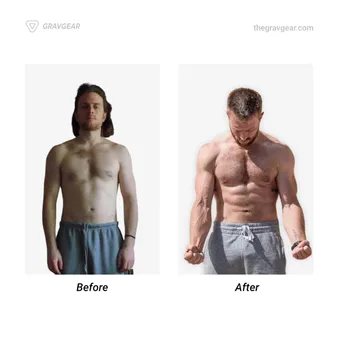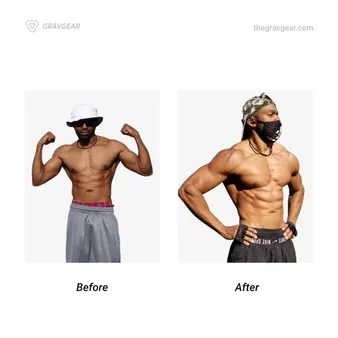Table of Contents
can you get big with calisthenics? It's a question that's been debated for years, with proponents of both sides claiming to have the answer. Some say that calisthenics is all you need to build a muscular physique, while others argue that it's impossible to gain significant muscle mass without lifting weights. So, what's the truth? Can you really get big with calisthenics? The answer, as with most things in life, is not a simple yes or no. It depends on a number of factors, including your genetics, training experience, and diet. But one thing is for sure: calisthenics can be an effective way to build muscle, and it's certainly possible to get big with calisthenics if you're willing to put in the work. If you're interested in learning more about calisthenics and how to use it to build muscle, then you're in the right place. At Kizworld, we're passionate about helping people achieve their fitness goals, and we believe that calisthenics is a great way to do just that.
Can You Get Big With Calisthenics? The Truth Revealed
Question | Answer |
|---|---|
Can you get big with calisthenics? | Yes, it's possible to build muscle mass with calisthenics, but it requires dedication and following certain principles. |
What is hypertrophy? | Muscle growth, caused by increasing the size of muscle fibers. |
How do you achieve progressive overload in calisthenics? | Gradually increase the difficulty of your exercises, either by adding reps, sets, or variations. |
What are some good calisthenics exercises for building muscle? | Pull-ups, push-ups, dips, squats, and lunges. |
What is a sample calisthenics workout plan for building muscle? | A full-body workout plan 3-4 days a week, focusing on compound exercises and progressive overload. |
How important is nutrition for building muscle with calisthenics? | Essential for providing the building blocks and energy for muscle growth. |
What are the limitations of calisthenics for building muscle? | Harder to isolate specific muscle groups and reach advanced levels of hypertrophy compared to weightlifting. |
How does calisthenics compare to weightlifting for building muscle? | Both effective methods, but weightlifting allows for heavier loads and more targeted muscle isolation |
Why is cross-training beneficial for building muscle? | Helps overcome plateaus, improves overall fitness, and reduces the risk of injuries. |
How do you stay motivated on your calisthenics journey? | Set realistic goals, find a supportive community, and enjoy the process. |
I. Can Calisthenics Help You Pack on Muscle?
The Potential of Calisthenics for Muscle Growth
Calisthenics, a form of bodyweight training, has gained popularity as a means to enhance strength and fitness. But can it help you build muscle? The answer is a resounding yes, with the right approach and dedication. Calisthenics utilizes compound exercises that engage multiple muscle groups simultaneously, stimulating hypertrophy (muscle growth) effectively. Moreover, the progressive nature of calisthenics allows for gradual increases in intensity, promoting constant muscle challenges and adaptations.
The Science Behind Calisthenics-Induced Muscle Growth
Calisthenics exercises induce muscle growth through a combination of mechanical tension and metabolic stress. As you perform these exercises, your muscles experience mechanical tension, which triggers muscle breakdown. This breakdown creates microscopic tears in the muscle fibers, which then repair and rebuild, leading to muscle growth. Additionally, calisthenics exercises often involve sustained muscle contractions, creating metabolic stress. This stress depletes energy stores within the muscles, forcing them to adapt by increasing their size and strength.
Maximizing Calisthenics for Muscle Growth
To maximize muscle growth through calisthenics, follow these principles:- Progressive overload: Gradually increase the difficulty of your exercises by adding reps, sets, or variations over time.- Compound exercises: Focus on exercises that work multiple muscle groups simultaneously, such as pull-ups, push-ups, and squats.- Adequate nutrition: Consume a balanced diet high in protein to provide the building blocks for muscle growth.- Rest and recovery: Allow sufficient rest between workouts and get quality sleep to facilitate muscle repair and recovery.If you're interested in learning more about calisthenics workouts, check out our article on how to design your own calisthenics routine. Additionally, you can find more tips on building muscle with calisthenics in our guide to calisthenics for beginners.
Calisthenics Exercise | Primary Muscle Group | Variations |
|---|---|---|
Pull-ups | Back | Wide-grip, narrow-grip, weighted |
Push-ups | Chest | Incline, decline, plyometric |
Squats | Legs | Bodyweight, weighted, jump |
Can Calisthenics Help You Pack on Muscle?
II. Calisthenics: A Path to Impressive Strength Gains
Understanding the Basics of Calisthenic Strength Development
Calisthenics, a form of bodyweight training, has gained immense popularity for its effectiveness in building strength and muscle. Contrary to the misconception that it's solely for beginners, calisthenics offers a challenging path to impressive strength gains for individuals of all fitness levels.The key to maximizing strength development through calisthenics lies in understanding the principles of progressive overload. Calisthenics exercises can be modified to increase difficulty, ensuring continuous challenges and fostering muscular adaptations. Advanced techniques like weighted vests or resistance bands can further intensify workouts, propelling strength gains.How to Build Muscle and Strength with Calisthenics
Leveraging Bodyweight for Maximum Strength Benefits
Unlike weightlifting, which utilizes external weights, calisthenics harnesses your bodyweight as resistance. This unique aspect forces muscles to work harder to stabilize and control movements effectively. Engaging multiple muscle groups simultaneously in compound exercises like pull-ups or squats enhances overall strength development.Calisthenics also promotes functional strength by mimicking everyday movements. As a result, you gain strength that translates directly to real-life situations, improving overall athleticism and performance in other activities.
Achieving Calisthenic Strength Mastery: Tips for Success
Embarking on a calisthenics journey requires dedication and consistency. Start by mastering foundational exercises like push-ups, squats, and pull-ups. Gradually introduce variations and progressions to challenge your muscles as they adapt. Remember to prioritize proper form to prevent injuries and maximize effectiveness.Set realistic goals and track your progress. Consistency is crucial for achieving significant strength gains. Engage in regular workouts, even if it's just for a short duration initially. Find a supportive community or workout partner for motivation and accountability.
Exercise | Focus | Benefits |
|---|---|---|
Pull-ups | Upper Body | Back, Biceps, Forearms |
Push-ups | Upper Body | Chest, Triceps, Shoulders |
Squats | Lower Body | Quads, Hamstrings, Glutes |
Calisthenics offers a rewarding path to impressive strength gains. By embracing the principles of progressive overload, leveraging bodyweight resistance, and following these tips, you can unlock your potential and achieve significant strength development. Remember, consistency, dedication, and a touch of perseverance will guide you towards your fitness goals.
Calisthenics: A Path to Impressive Strength Gains
III. Maximizing Calisthenics for Muscle Growth: Advanced Techniques
Achieving impressive muscle growth with calisthenics demands a strategic approach that goes beyond the basics. To unlock your full potential, consider incorporating these advanced techniques into your routine.* **Weighted Calisthenics:** Add external weight to your body using weight vests or resistance bands. This increases the intensity, promoting greater muscle activation and faster hypertrophy.* **Plyometrics:** Incorporate explosive movements like jump squats and clap push-ups. These exercises challenge your muscles with sudden force, improving power output and muscle fiber recruitment.
Exercise | Target Muscles | Sets | Repetitions |
|---|---|---|---|
Weighted Pull-ups | Back, Biceps | 3-4 | 8-12 |
Plyometric Push-ups | Chest, Triceps | 3-4 | 6-10 |
* **Supersets and Drop Sets:** Combine exercises that target the same or opposing muscle groups with minimal rest. This technique keeps your muscles under constant tension, maximizing time under load and stimulating muscle growth.
- Related Post: How to increase muscle mass with calisthenics?
* **Isometrics:** Hold exercises at their most challenging point, applying maximum force against an immovable object. This technique builds strength and endurance, improving muscle density and overall power.* **TUT Training:** Time Under Tension training involves extending the time your muscles spend under load during each repetition. By slowing down your movements, you increase muscle activation and promote greater hypertrophy.
- Related Post: how to get shredded with calisthenics?
These advanced techniques can significantly enhance your calisthenics training, helping you build impressive muscle mass and unlock your full potential.
Maximizing Calisthenics for Muscle Growth: Advanced Techniques
IV. Customized Calisthenics: Tailoring Workouts for Individual Goals
Calisthenics offers a versatile approach to fitness, allowing individuals to tailor their workouts to suit their specific goals. Whether you're a beginner seeking to improve overall fitness or an experienced athlete aiming for advanced muscle development, customizing your calisthenics routine is key to maximizing results.
To craft a personalized calisthenics plan, start by identifying your fitness objectives. Are you primarily interested in building muscle, enhancing endurance, or improving flexibility? Once you have a clear understanding of your goals, you can begin selecting exercises and structuring your workouts accordingly.
Goal | Recommended Exercises |
|---|---|
Muscle Building | Weighted calisthenics, plyometrics, advanced progressions |
Endurance | High-repetition bodyweight exercises, circuit training, interval training |
Flexibility | Dynamic stretching, yoga, Pilates |
In addition to selecting appropriate exercises, consider your fitness level when customizing your calisthenics routine. Beginners should start with bodyweight exercises that focus on proper form and technique. As you progress, you can gradually increase the difficulty by adding weight, performing more repetitions, or incorporating advanced variations.
For those seeking to build muscle with calisthenics, progressive overload is essential. This involves gradually increasing the intensity of your workouts over time to stimulate muscle growth. You can achieve progressive overload by adding weight, increasing repetitions, or reducing rest periods.
Remember, consistency is key when it comes to calisthenics. Aim to train regularly, whether it's three times a week or every other day. By following a tailored calisthenics plan and staying consistent with your workouts, you can achieve your fitness goals and unlock your full potential.
- How to Do a Muscle-Up
- The Best Calisthenics Gifts and Accessories
- The Best Calisthenics Quotes and Motivation
Customized Calisthenics: Tailoring Workouts for Individual Goals
V. Conclusion
Can you get big with calisthenics? The answer is a resounding yes! Calisthenics can be an incredibly effective way to build muscle, strength, and athleticism. If you're looking to get big, calisthenics is a great option. Just be sure to eat a healthy diet, get enough protein, and train consistently.